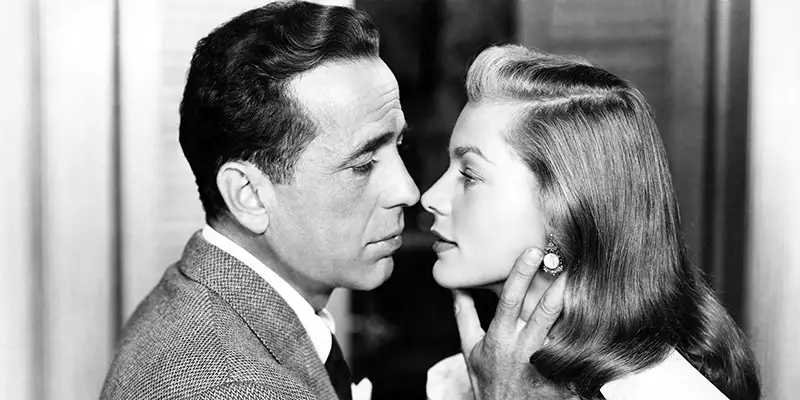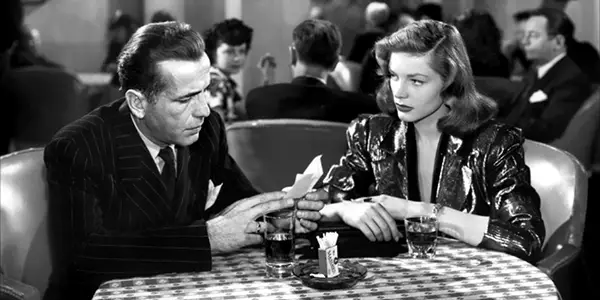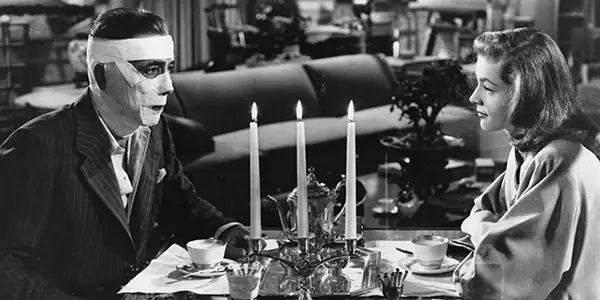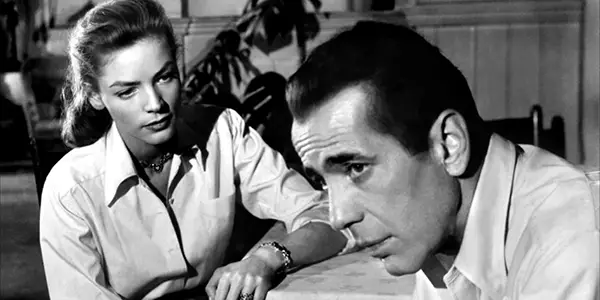A Most Romantic Collaboration: Bacall & Bogart

Alex has an unhealthy obsession with classic films.
I can’t think of any other couple that exemplified the pure nature of an old Hollywood romance other than Humphrey Bogart and Lauren Bacall. If you take a quick glimpse at their history together, the love they shared was palpable. Bacall was only nineteen when they met (twenty when they married), and Bogart was old enough to be her father.
During their ten-year marriage, they co-starred in four films together. If you watch these films, you’ll be transported back to a world where black-and-white was the preferred, and pretty much only option directors had. Now, I don’t object to this, but most modern film “fans” would scoff at the thought of a movie being in black-and-white. But, on the contrary, these movies were overflowing with innuendo and suggestive dialogue (due to the fact that Hays Code[expand] The Hays Code was the set of moral guidelines in the film industry. It was applied to most Hollywood films released by major studios from 1930 to 1968. The Code spelled out what was acceptable and what was unacceptable content for motion pictures produced for a public audience in the United States. For a complete list of the guildelines, check here.[/expand] was in full effect), that would rival any Verhoeven movie; and with Bogart and Bacall as the leads, it’s definite that those feelings were real.
Learning How To Whistle
Lauren Bacall got her first job under extraordinary circumstances. She was working as a theater usher when she landed the cover of the March 1943 issue of Harper’s Bazaar. The cover then caught the attention of Nancy “Slim” Keith, who happened to be married to legendary director Howard Hawks at the time. Nancy mentioned it to her husband, and all of a sudden, Bacall was on her way to her first ever screen test.
To Have and Have Not stars Humphrey Bogart, Lauren Bacall and Walter Brennan. Set in Martinique, Bogart plays American expatriate Harry Morgan, who owns a charter boat that he loans out to tourists. Bacall plays Marie “Slim” Browning, a pickpocket and cabaret singer who quickly takes a liking to our protagonist.

This film (like most Bogart/Bacall collaborations) is a bit confusing to read on paper; I don’t think I could explain the plot any further before revealing any spoilers. I genuinely believe it’s best experienced as it was supposed to be – on the silver screen. As for the acting, it certainly was a breakout role for Bacall. In fact, some of the most memorable scenes in the film are attributed to Bacall.
There was a scene[expand]https://www.youtube.com/watch?v=huTKkFSn8us[/expand] (the first appearance she makes in the film, actually) where she is walking back to her dressing room after singing her heart out on stage. In one of the rooms she has to walk past, she spots Bogart‘s character Harry. She walks inside and stoically asks, “Anybody got a match?” Mesmerized by her silhouette, Harry fumbles into his coat pocket, takes out a matchbox, and throws it straight at her, to which she responds with a simple: “Thanks.” It’s scenes like this that make this movie one to remember.
It’s no surprise that Bogart fell in love with Bacall while filming. He was married to actress Mayo Methot at the time, who was notoriously temperamental, so their courtship would be reduced to love letters and sneaking away together after they were done filming. Eventually, Bogart ended up divorcing his former wife, and on May 21st, 1945, Bacall and Bogart would marry at Malabar Farm, in Lucas, Ohio.
The Big Sleep
The next film they did, this time as a married couple, was The Big Sleep. This film noir was directed again by Howard Hawks, and stars Humphrey Bogart, Lauren Bacall, Martha Vickers and Charles Waldron. The movie is an adaption of the Raymond Chandler book of the same name. Bogart plays detective Phillip Marlowe, who is asked to investigate gambling debts of Carmen Sternwood (played by Martha Vickers) at the request of her father General Sternwood (played by Charles Waldron). Vivian Sternwood, played by Bacall, is weary of her father’s true motives, stopping Marlowe at the front door before he leaves. The investigation eventually leads Marlowe into a world of corruption, double crossing and despair.

Like I mentioned before, these films were made smack dab in the middle of Hays Code, a production rule limiting what you can say or do; it’s pretty much the MPAA before we had any real ratings. Due to these circumstances, the plot is one big whodunit with no clear answer (not to mention the fluid sexuality that is rampant throughout the book). I had to have the film’s Wikipedia page open while I watched the movie – I repeat, your first viewing of this movie will probably not be a pleasant experience. It truly takes a willingness to rewatch this again.
On the bright side, The Big Sleep was added the Library of Congress’ National Film Registry in 1997, and is considered one of Humphrey Bogart’s greatest roles.
Dark Passage
Probably one of the more innovative films that I’ve seen, Dark Passage was written and directed by Delmer Daves and stars Bogart and Bacall again in leading roles. Bogart plays Vincent Parry, a man in prison for allegedly killing his wife. Instead of sitting in jail cells wasting his life away, he decides to escape from his purgatory. On his trek away from San Quentin, he meets a women named Irene Jensen (played by Bacall) who takes him in, offering him clean clothes and a fresh shave.
Here’s where it gets intriguing: in order to stay a free man, Parry goes under the knife in a sketchy back alley surgery to alter his appearance. For the duration of the film, Parry weaves his way through the justice system while simultaneously romancing the young lady he has at his side.

One of the more unique aspects about Dark Passage is its cinematography. Daves decided that the first third of the film would be from the point of view of Vincent Parry, up until the big reveal. The same sense of panic and urgency that Vincent Parry is feeling is felt as an audience member. It is definitely captivating; not only do you not know who this man is supposed to be, but you then somehow feel sympathy for him as the protagonist. Not only is this film a classic piece of film noir history, it’s also a highly underappreciated film from this duo.
Key Largo
As a Florida resident, this film has a special place in my heart. The wind, the waves, the potential hurricane on the horizon – all of this I call home. Directed by John Huston, Key Largo stars Edward G Robinson, Lionel Barrymore, Humphrey Bogart and Lauren Bacall in what would be their last film together. Ex military man Frank McCloud arrives at the Hotel Largo to visit the family of an ex army buddy who died in combat.
Turns out his friend’s widow (played by Bacall) and his father (played by Barrymore) manage this rundown hotel. Due to unforeseen circumstances, a mob of gangsters come, led by a man with the most stereotypical gangster name ever, Johnny Rocco (played by Robinson), who holds them hostage. To make matters worse, there’s a hurricane on the horizon.

Probably one of the lesser know of both Bogart and Bacall films, Key Largo is basically a classic film lover’s dream. The atmosphere you feel is something I haven’t experienced very often. From masterfully crafted acting by Robinson and Bogart, to the different nuances Bacall gives her character, and even an Oscar win, be sure to watch this if you’re in the mood for a fantastically directed and acted film.
The End
Like all great collaborations, they eventually have to come to an end. Lauren Bacall would continue to star in fewer and fewer films as her career progressed, the most notable being How To Marry A Millionaire, Douglas Sirk’s Written On The Wind, and Designing Woman. She would pass away on August 12, 2014, leaving behind an incredible legacy.
Humphrey Bogart, on the other hand, continued forging a legend that would be remembered for years to come. With an Oscar win for his role in The African Queen and multitude other movies, Bogart was well on his way to becoming a Hollywood legend. Sadly, Bogart would pass away from a long fight with esophageal cancer on January 14, 1957.
Without these two, we wouldn’t have these films, and if we didn’t have these films, I wouldn’t know what to do with myself.
What is your favorite Humphrey Bogart film, and what your favorite Lauren Bacall film? Let me know in the comments.
(top image: Dark Passage (1947) – source: Warner Bros.)
Does content like this matter to you?
Become a Member and support film journalism. Unlock access to all of Film Inquiry`s great articles. Join a community of like-minded readers who are passionate about cinema - get access to our private members Network, give back to independent filmmakers, and more.
Alex has an unhealthy obsession with classic films.













